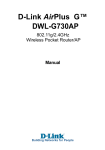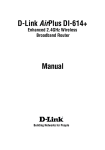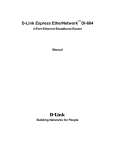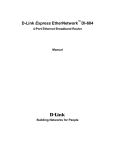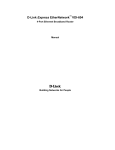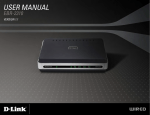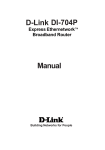Download Dynex DX-E401 - EN Broadband Router Installation guide
Transcript
4-Port Cable/DSL Router Product Name [French] Product Name [Spanish] DX-E401 U S E R G U I D E • G U I D E D E L’ U T I L I S AT E U R • G U Í A D E L U S UA R I O 2 Introduction Dynex 4-Port Cable/DSL Router Introduction This router enables you to quickly and easily share a high-speed Internet connection. The router also incorporates many advanced features traditionally found in more expensive routers. After completing the steps outlined in the Installation Guide (included in your package) you will be able to share a single Internet connection, as well as sharing information and resources (such as files and printers) on your local network. The router is compatible with most popular operating systems, including Windows, Linux, and Macintosh, and can be integrated into an existing network. This manual provides a quick introduction to broadband router technology, firewalls, and local area networking. Take a moment to read through this manual and get acquainted these technologies. Contents Introduction..................................................................................................2 Important safety instructions .......................................................................3 Introduction to broadband router technology...............................................3 Features ........................................................................................................4 Product components.....................................................................................6 Setting up the router ....................................................................................7 Configuring the router ................................................................................13 Configuring your computers........................................................................45 Troubleshooting..........................................................................................56 Specifications..............................................................................................57 Warranty.....................................................................................................58 Legal notices...............................................................................................59 Français ............................................................. 61 Español .............................................................. xx Important safety instructions 3 Important safety instructions These precautions explain how to safely operate your new router, preventing injury to you or to others, or damage to the router. Warning - read this carefully before proceeding. • Do not open the router or attempt to disassemble or modify it. • Do not insert fingers or foreign objects into the router. • Do not expose the router to rain, use it near water or in damp or wet conditions, or place containers on it that contain liquids which might spill into openings. • Follow the Installation Guide and this User Guide carefully. Follow the correct procedures when setting up the router. Introduction to broadband router technology A router is a device that forwards data packets from a source to a destination using IP addresses, not MAC addresses. A router forwards data from the Internet to a particular computer on your network. The information that makes up the Internet gets moved around using routers. When you click on a link on a Web page, you send a request to a server to show you the next page. The information that is sent and received from your computer is moved from your computer to the server using routers. A router also determines the best route that your information should follow to ensure that the information is delivered correctly. A router controls the amount of data that is sent through your network by eliminating information that should not be there. This provides security for the computers connected to your router, because computers from the outside cannot access or send information directly to any computer on your network. The router determines which computer the information should be forwarded to, then sends it. If the information is not intended for any computer on your network, the data is discarded. This keeps unwanted or harmful information from accessing or damaging your network. 4 Features Firewalls A firewall is a device that is set up between your computer and the Internet which prevents unauthorized access to or from your network. A firewall can be a computer using firewall software or a device built specifically to act as a firewall. In most circumstances, a firewall is used to prevent unauthorized Internet users from accessing your network. A firewall analyzes all of the information moving to and from your network and analyzes each piece of data and checks it against a set of criteria that the administrator sets. If any data does not meet the criteria, that data is blocked and discarded. If the data meets the criteria, the data is passed through. This is called packet filtering. A firewall can also run specific security functions based on the type of software or type of port that is being used. For example, a firewall can be configured to work with an FTP or Telnet server, or with specific UDP or TCP ports to allow certain software or games to work correctly over the Internet. LANs and WANs A Local Area Network (LAN) is several computers connected together within a small area such as a building or group of buildings. A collection of LANs connected over a large area is called a Wide Area Network (WAN). Although there are many ways to connect computers together, the most common way is Cat-5 cable (UTP or STP twisted pair wire). Wireless networks, which use radio waves instead of wires, are becoming more common. Each computer must have a Network Interface Card (NIC), which transfers the data between computers. A NIC can be a 10 Mbps, 10/100 Mbps, or 10/100/1000 Mbps network card. Most networks use hardware devices such as hubs or switches to connect computers. A hub takes any data arriving through each port and forwards the data to all other ports. A switch is more sophisticated, in that a switch can determine the destination port for a specific piece of data. A switch minimizes network traffic overhead and speeds up communication over a network. Features BROADBAND MODEM AND IP SHARING Connects multiple computers to a broadband (cable or DSL) modem to share the Internet connection. Features 5 ETHERNET SWITCH Allows you to quickly and easily share an Internet connection with multiple computers and devices. VPN SUPPORTED Supports multiple and concurrent IPSec and PPTP pass-through sessions, so multiple users behind the router can access corporate networks through various VPN clients more securely. ADVANCED FIREWALL AND PARENTAL CONTROL FEATURES The Web-based user interface displays a number of advanced network management features including: Content filtering—Easily applied content filtering based on MAC address, IP address, URL, or domain name. Filter scheduling—Filters can be scheduled to be active on certain days or for a duration of hours and minutes. Network Address Translation (NAT)—Allows your networked computers to share a single IP address and protects you from outside intruders gaining access to your private network. DHCP SERVER SUPPORTED All networked computers can retrieve TCP/IP settings automatically from the router. WEB-BASED MANAGEMENT The router is configurable through any network computer’s Web browser. ACCESS CONTROL SUPPORTED Allows you to assign user-specific access rights. VIRTUAL SERVER SUPPORTED Allows you to make WWW, FTP, and other services on your LAN accessible to Internet users. SPECIAL APPLICATIONS SUPPORTED Special applications requiring multiple connections are supported, such as Internet gaming, video conferencing, and Internet telephony. The router can detect the application type and open a multi-port tunnel for it. 6 Features DMZ HOST SUPPORTED Allows a networked computer to be fully exposed to the Internet. This function is used when the Special Applications feature is insufficient to allow an application to function correctly. System requirements for configuration • Ethernet-based cable or DSL modem • Computers with Windows, Macintosh, or Linux-based operating systems with an installed Ethernet adapter • Internet Explorer Version 6.0 or Netscape Navigator 6.0 and above Product components FRONT PANEL Power indicator Component WAN indicator LAN link/activity indicators Function Power indicator Turns green when the router is plugged in. WAN indicator Turns green when a WAN connection exists. LAN link/activity indicators Turns green when connected to a network device. Flashes when the corresponding port is sending or receiving data. 7 Setting up the router REAR PANEL WAN port LAN ports Component Reset button Power connector Function Reset button Press to restore the router to factory default settings. LAN ports 1-4* The LED glows steadily when a port is connected to a network device in your local area network (LAN.) WAN port* Connect your cable or DSL modem to this port. Power connector Connect one end of the included power adapter to the power connector and the other end to a power outlet. *All ports (both LAN and WAN) are Auto-MDIX. All ports auto-sense cable types to accommodate straight-through or crossover cable. Setting up the router Network settings To use the router, you must correctly configure the network settings of your computers. The default IP address of the router is 192.168.0.1, and the default subnet mask is 255.255.255.0. These addresses can be changed as needed, but the default values are used in this manual. If the TCP/IP environment of your computer has not yet been configured, see “Configuring your computers” on page 45, for information. We recommend that you configure your computers to obtain TCP/IP settings automatically from the DHCP server feature of the router. 8 Setting up the router Since the IP address of the router is 192.168.0.1, the IP address of your computer must be 192.168.0.X (where “X” is a number between 2 and 254.) Each computer on your network must have a different IP address within that range. The default gateway must be 192.168.0.1 (the IP address of the router). Web-based management utility The router has a Web-based management utility which is operating system independent. You can configure your router through a Java Script enabled Web browser in Windows, Macintosh, Linux, or UNIX-based platforms. START UP AND LOG IN To access the Web-based management utility: 1 Open your Web browser and enter the IP address of the router into the Location (for Netscape) or Address (for Internet Explorer) field, then press Enter. The default IP address of the router is 192.168.0.1 For example, type 192.168.0.1 After the connection is established, the logon screen opens. 2 To log in as an administrator, enter the user name of admin and leave the password field blank (default), then click OK. The Web management Home screen opens. Setting up the router 9 Using the Setup Wizard Follow the Wizard step-by-step to quickly configure the router. To use the Setup Wizard: 1 Start the Web-based management utility. (For more information, see Start up and Log in on page 8.) The Web Management Home screen opens. 2 Click Run Wizard. The DX-E401 Setup Wizard starts. 3 Click Next. The Set Password screen opens. 4 5 6 7 8 For security purposes, we recommend that you change the default admin password (that is, no password). Type your new password, then type it in the Verify Password field a second time for confirmation. Click Next to continue. The Choose Time Zone screen opens. Click on the list to open it, then click the correct time zone for your location. Click Next. The router will try to auto-detect your Internet connection type. If you have a Dynamic or PPPoE connection, and the router detects the connection, the corresponding page opens. If the Select Internet Connection Type (WAN) screen opens, select the type of Internet connection that your ISP provides, then click Next. • Dynamic IP Address—(for example, cable users) Select this option to obtain an IP address automatically from your ISP. For more information, 10 Setting up the router see Selecting a dynamic IP address in Windows XP or Windows 2000 on page 53. • Static IP Address—Select this option to manually input the IP address that your ISP assigns to you. For more information, see Assigning a static IP address in Windows XP and Windows 2000 on page 51. • PPP over Ethernet (PPPoE)—(for example, DSL users) Select this option if your ISP requires the use of PPPoE to connect to their services. For more information, see Configuring PPPoE on page 16. 9 If you selected Dynamic IP Address, go to Step 10. If you selected Static IP Address, go to Step 13. If you selected PPP over Ethernet, go to Step 16. Setting up the router 11 10 If you selected Dynamic IP Address, the Set Dynamic IP Address screen opens. Note - This setup should be done on the computer that is registered with your ISP. 11 If your ISP requires you to enter a specific host name or specific MAC address, enter it here. Click Clone MAC Address to copy the MAC address of your Ethernet adapter to the MAC address fields (you can also type it in manually). 12 Go to step 18. 12 Setting up the router 13 If you selected Static IP Address, the Set Static IP Address screen opens. 14 Type the IP address information provided to you by your ISP, including: • WAN IP Address • WAN Subnet Mask • WAN Gateway Address • Primary DNS Address 15 Go to step 18. Configuring the router 13 16 If you selected PPP over Ethernet (PPPoE), the Set PPPoE screen opens. Note - Make sure that you remove any existing PPPoE client software installed on your computers. 17 Type the Username and Password provided to you by your ISP, and type the Service Name if your ISP uses a service name for the PPPoE connection. 18 Click Next. The Setup Completed screen opens. 19 Click Restart. The router saves the changes and reboots. 20 Click Close. The router setup is now complete, and you should be able to access the Internet. Configuring the router Whenever you want to reconfigure your network or the router, you can access the Web-based configuration utility by opening your Web browser and typing in the IP Address of the router. The default IP Address is: 192.168.0.1 (also see Start-up and Log in on page 8). To access the Web-based configuration utility: 1 Open your Web browser. 2 Type in the IP Address of the router (http://192.168.0.1). 14 Configuring the router Note - if you have changed the default IP Address assigned to the router, make sure to enter the new IP Address. 3 Type admin in the User Name field, and type your password in the Password field (default is blank, unless you have changed it), then click OK. The utility’s Home screen opens. WAN CONFIGURING A DYNAMIC IP ADDRESS A dynamic IP address obtains IP Address information automatically from your ISP. Use this if your ISP does not give you IP address numbers to use. This option is commonly used for cable modem services. To configure your router to obtain a dynamic IP address: 1 Access the Web-based configuration utility by following the instructions in To access the Web-based configuration utility: on page 13. 2 Click the WAN button. The WAN Settings screen opens. 3 Click Dynamic IP Address, then enter the following settings, as appropriate: Field Host Name Description The Host Name is optional but may be required by some ISPs. The default host name is the device name of the router and may be changed. 15 Configuring the router Field Description MAC Address The default MAC address is set to the WAN's physical interface MAC address on the broadband router. We do not recommend that you change the default MAC address unless required by your ISP. Clone MAC Address The default MAC address is set to the WAN's physical interface MAC address on the broadband router. You can click Clone MAC Address to copy the MAC address of your Ethernet card, or you may be required to enter the MAC address of your router. We recommend that you do not change the default MAC address unless required by your ISP. Primary/Secondary DNS Address Use this if you do not want to use the one provided by your ISP. MTU Use only if required by your ISP. Otherwise, leave the default setting. CONFIGURING A STATIC IP ADDRESS Set a static IP address if all WAN IP information is provided to you by your ISP. You will need to enter in the IP address, subnet mask, gateway address, and DNS address(es) provided to you by your ISP. Each IP address entered in the fields must be in the appropriate IP form, which are four numbers (up to three digits each) separated by a dot (x.x.x.x). The router will not accept the IP address if it is not in this format. To configure a static IP address: 1 Open the Configuration menu by following the instructions in To access the Web-based configuration utility: on page 13. 16 Configuring the router 2 Click the WAN button. The WAN Settings screen opens. 3 Click Static IP Address, then enter the following settings, as appropriate: Field Description IP Address IP address assigned to you by your ISP. Subnet Mask All devices in the network must have the same subnet mask. The default is 255.255.255.0 ISP Gateway Address The public IP address of the ISP to which you are connecting. Primary DNS Address The primary DNS (Domain Name Server) IP address provided by your ISP. Secondary DNS Address Optional MTU Use only if required by your ISP. Otherwise, leave the default setting. CONFIGURING PPPOE Choose PPPoE (Point-to-Point Protocol over Ethernet) if your ISP uses a PPPoE connection. Your ISP provides you with a username and password. This option is typically used for DSL services. Select Dynamic PPPoE to obtain an IP address automatically for your PPPoE connection. Select Static PPPoE to use a static IP address for your PPPoE connection. 17 Configuring the router Make sure that you remove existing PPPoE client software installed on your computers. To configure PPPoE: 1 Access the Configuration menu by following the instructions in To access the Web-based configuration utility: on page 13. 2 Click the WAN button. The WAN Settings screen opens. 3 Click PPPoE, then enter the following settings, as appropriate: Field Description Dynamic PPPoE Click this if you receive an IP address automatically from your ISP. Static PPPoE Click this if you have an assigned (static) IP Address. User Name Your PPPoE username provided by your ISP. Password Your PPPoE password. Retype Password Re-enter the PPPoE password Service Name The Service Name provided by your ISP (optional). 18 Configuring the router Field Description IP Address The static IP Address for the PPPoE connection. This option is only available for Static PPPoE. Primary DNS Address The primary DNS IP address provided by our ISP. Secondary DNS Address The static IP Address for the PPPoE connection. This option is only available for Static PPPoE. MTU Maximum Transmission Unit-1492 is the default setting. You may need to change the MTU for optimal performance with your specific ISP. Auto-reconnect If this is enabled, the router will automatically connect to your ISP after your system is restarted or if the PPPoE connection is dropped. CONFIGURING PPTP PPTP, or Point-to-Point Tunneling Protocol, is a WAN connection type used in Europe. To configure PPTP: 1 Access the Configuration menu by following the instructions in To access the Web-based configuration utility: on page 13. 2 Click the WAN button. The WAN Settings screen opens. 19 Configuring the router 3 Click PPTP, then enter the following settings, as appropriate: Field Description My IP Address Your IP address. My Subnet Mask Tour subnet mask. Server IP Address The server IP address. PPTP Account The PPTP account name. PPTP Password Your PPTP password. Connection ID The connection ID if required by your ISP. (Optional) Maximum Idle Time The maximum idle time during which your Internet connection is maintained during inactivity. To disable this feature, enable Auto-reconnect. CONFIGURING BIGPOND CABLE Dynamic IP Address for BigPond is a WAN connection used in Australia. To configure BigPond Cable: 1 Access the Configuration menu by following the instructions in To access the Web-based configuration utility: on page 13. 2 Click the WAN button. The WAN Settings screen opens. 20 Configuring the router 3 Click BigPond Cable, then enter the following settings, as appropriate: Field Description User Name The username for your BigPond account. Password The password for your BigPond account. Login Server IP The IP address of the Login Server, if required. (Optional) Renew IP forever If this is enabled, the router automatically connects to your ISP after it is restarted or when the connection is dropped. LAN CONFIGURING YOUR LAN LAN is short for Local Area Network, and is considered your internal network. These are the IP settings of the LAN interface for the router. The LAN IP address is private to your internal network and cannot be seen on the Internet. To configure your LAN: 1 Access the Configuration menu by following the instructions in To access the Web-based configuration utility: on page 13. 2 Click the LAN button. The LAN Settings screen opens. 3 Enter the following settings, as appropriate: Field Description IP Address The IP address of the LAN interface. The default IP address is: 192.168.0.1 Subnet Mask The subnet mask of the LAN interface. The default subnet mask is 255.255.255.0 21 Configuring the router Field Description Local Domain Name The local domain name. (Optional) DHCP CONFIGURING YOUR DHCP SERVER DHCP stands for Dynamic Host Control Protocol. The router has a built-in DHCP server which will automatically assign an IP address to the computers on the LAN. Set your computers to be DHCP clients by setting their TCP/IP settings to Obtain an IP Address Automatically. When you turn your computers on, they will automatically load the proper TCP/IP settings provided by the router. The DHCP Server will automatically allocate an unused IP address from the IP address pool to the requesting computer. You must specify the starting and ending address of the IP address pool. To configure your DHCP server: 1 Access the Configuration menu by following the instructions in To access the Web-based configuration utility: on page 13. 2 Click the DHCP button. The DHCP Server screen opens. 3 Click Enabled, then enter the following settings, as appropriate: Field Starting IP Address Description The starting IP address for the DHCP server's IP assignment. 22 Configuring the router Field Description Ending IP Address The ending IP address for the DHCP server's IP assignment. Lease Time The length of time for the IP lease. The default setting is one hour. Advanced CONFIGURING A VIRTUAL SERVER The router can be configured as a virtual server so that remote users accessing Web or FTP services with a public IP address can automatically be redirected to local servers in the LAN (Local Area Network). The router firewall feature filters out unrecognized packets to protect your LAN so that all computers networked with the router are invisible to the outside world. If you want, you can make some of the LAN computers accessible from the Internet by enabling Virtual Server. Depending on the requested service, the router redirects the external service request to the appropriate server within the LAN network. The router is also capable of port-redirection. Port-redirection takes incoming traffic to a particular port and redirects it to a different port on the server computer. Each virtual service that is created are listed at the bottom of the screen in the Virtual Servers List. Pre-defined virtual services are already in the table. You can use them by enabling them and assigning the server IP to use that particular virtual service. To configure a virtual server: 1 Access the Configuration menu by following the instructions in To access the Web-based configuration utility: on page 13. 23 Configuring the router 2 Click the Advanced tab, then click Virtual Server. The Virtual Server screen opens. 3 Click Enabled, then enter the following settings, as appropriate: Field Description Name The name referencing the virtual service. Private IP The IP address of the server computer in the LAN (Local Area Network) that will be providing the virtual services. Protocol Type The protocol used for the virtual service. Private Port The port number of the service used by the private IP computer. Public Port The port number on the WAN (Wide Area Network) side that will be used to access the virtual service. Schedule The times when the virtual service will be enabled. The schedule may be set to Always, which will allow the particular service to always be enabled. If it is set to Time, select the time frame for the service to be enabled. If the system time is outside of the scheduled time, the service will be disabled. 24 Configuring the router Example #1: If you have a Web server that you wanted Internet users to be able to access at all times, you would need to enable it. Web (HTTP) server is on LAN (Local Area Network) computer 192.168.0.25. HTTP uses port 80, TCP. Name: Web Server Private IP: 192.168.0.25 Protocol Type: TCP Private Port: 80 Public Port: 80 Schedule: always Click this icon to edit the virtual service. Click this icon to delete the virtual service. Example #2: If you have an FTP server that you wanted Internet users to access by WAN port 2100 and only during the weekends, you would need to enable it as such. The FTP server is on LAN computer 192.168.0.30, and uses port 21, TCP. Name: FTP Server Private IP: 192.168.0.30 Protocol Type: TCP Private Port: 21 Public Port: 2100 Schedule: From: 01:00AM to 01:00AM, Sat to Sun All Internet users who want to access this FTP Server must connect to it from port 2100. This is an example of port redirection and can be useful in cases where there are many of the same servers on the LAN network. Configuring the router 25 CONFIGURING SPECIAL APPLICATIONS Some applications require multiple connections, such as Internet gaming, video conferencing, and Internet telephony. These are applications that have difficulties working through NAT (Network Address Translation). Special Applications makes some of these applications work with the router. To run applications that require multiple connections: 1 Specify the port normally associated with an application in the Trigger Port field, then select the protocol type as TCP or UDP. 2 Enter the public ports associated with the trigger port to open them for inbound traffic. 3 The router provides some predefined applications in the table on the bottom of the Web page. Select the application you want to use, then click Enable to enable it. Note - Only one computer can use each Special Application tunnel. To configure special applications: 1 Access the Configuration menu by following the instructions in To access the Web-based configuration utility: on page 13. 2 Click the Advanced tab, then the Application button. The Special Application screen opens. 26 Configuring the router 3 Enter the following settings, as appropriate: Field Description Name The name referencing the special application. Trigger Port The port used to trigger the application. It can be either a single port or a range of ports. Trigger Type The protocol used to trigger the special application. Public Port The port number on the WAN side that will be used to access the application. You can define a single port or a range of ports. You can use a comma to add multiple ports or port ranges. Public Type The protocol used for the special application. CONFIGURING IP FILTERS Filters are used to deny or allow LAN computers from accessing the Internet. The router can be set up to deny access to internal computers by their IP or MAC addresses. The router can also block users from accessing restricted Web sites. To configure IP filters: 1 Access the Configuration menu by following the instructions in To access the Web-based configuration utility: on page 13. 2 Click the Advanced tab, then the Filters button. The Filters screen opens. 27 Configuring the router 3 Click IP Filters, then click Enabled. 4 Enter the following settings, as appropriate: Field Description IP The IP address of the LAN computer that will be denied access to the Internet. Port The single port or port range that will be denied access to the Internet. Protocol Type The protocol type for the selected filter. Schedule The days and times when the IP filter will be enabled. CONFIGURING URL BLOCKING URL blocking is used to deny LAN computers access to specific Web sites by the URL. A URL is a specially formatted text string that defines a location on the Internet. If any part of the URL contains the blocked word, the site will not be accessible and the Web page will not display. To block a text string: 1 Enter the text string to be blocked, then click Apply. The text to be blocked appears in the list. 2 To delete the text, highlight it and click Delete. To configure URL blocking: 1 Access the Configuration menu by following the instructions in To access the Web-based configuration utility: on page 13. 2 Click the Advanced tab, then the Filters button. The Filters screen opens. 28 Configuring the router 3 Click URL Blocking, then click Enabled. 4 Enter the following, as appropriate: Field Keywords Description This setting blocks URLs which contain keywords you enter. CONFIGURING MAC FILTERS Use MAC filters to allow or deny LAN computers access to the network, based on their MAC addresses. You can either manually add a MAC address or select the MAC address from the list of clients that are currently connected to the broadband router. To configure MAC filtering: 1 Access the Configuration menu by following the instructions in To access the Web-based configuration utility: on page 13. 2 Click the Advanced tab, then the Filters button. The Filters screen opens. 3 Click MAC Filters, then click one of the following: • Disable MAC filters • Only allow computers with MAC addresses listed below to access the network • Only deny computers with MAC addresses listed below to access the network 29 Configuring the router 4 Enter the following, as appropriate: Field Description Name The filter name. MAC Address The MAC address(es) you want affected by the selected filter. DHCP Client Select a DHCP client from the pull-down list, then click Clone to copy that MAC address. CONFIGURING DOMAIN BLOCKING Domain blocking is used to allow or deny LAN computers access to specific domains on the Internet. Domain blocking will deny all requests to a specific domain such as http and ftp. It can also allow computers to access specific sites and deny all other sites. To configure domain blocking: 1 Access the Configuration menu by following the instructions in To access the Web-based configuration utility: on page 13. 2 Click the Advanced tab, then the Filters button. The Filters screen opens. 30 Configuring the router 3 Click domain blocking, then click one of the following: • Disabled—disables domain blocking • Allow—allows access to all domains except Blocked Domains • Deny—denies users access to all domains except Permitted Domains 4 Enter the following, as appropriate: Field Description Permitted Domains The domains to which access is allowed. Blocked Domains The domains to which access is blocked. CONFIGURING FIREWALL RULES Firewall rules is an advanced feature used to deny or allow traffic from passing through the router. It works in the same way as IP Filters with additional settings. You can create more detailed access rules for the router. When virtual services are created and enabled, they also display in firewall rules. Firewall Rules contain all network firewall rules pertaining to IP (Internet Protocol). The priorities of the Firewall Rules are listed in the firewall rules List at the bottom of the screen, with the highest priority rules at the top and the lowest at the bottom. Note - The router MAC address filtering rules have precedence over the Firewall Rules. To configure Firewall Rules: 1 Access the Configuration menu by following the instructions in To access the Web-based configuration utility: on page 13. 31 Configuring the router 2 Click the Advanced tab, then the Firewall button. The Firewall Rules screen opens. 3 Click Firewall Rules, then click one of the following: • Enabled—Enables the firewall • Disabled—Disables the firewall 4 Enter the following, as appropriate: Field Name Description The name of the firewall. Action Allow or Deny access to the selected range of IP addresses. Source The IP address range. Destination The IP address range, the protocol, and the port range. Schedule The time period when the firewall rules apply. Click Always or enter a time range. 32 Configuring the router CONFIGURING THE DMZ If you have a client PC that cannot run Internet applications correctly from behind the router, then you can set the client up for unrestricted Internet access. Unrestricted access allows a computer to be exposed to the Internet (useful for gaming). Enter the IP address of the internal computer that will be the DMZ host. Adding a client to the DMZ (Demilitarized Zone) may expose your local network to a variety of security risks, so only use this option as a last resort. To configure the DMZ: 1 Access the Configuration menu by following the instructions in To access the Web-based configuration utility: on page 13. 2 Click the Advanced tab, then the DMZ button. The DMZ screen opens. 3 Click one of the following: • Enabled—Enables the DMZ • Disabled—Disables the DMZ 4 Enter the following, as appropriate: Field IP Address Description The IP address of the computer to be in the DMZ. 33 Configuring the router Tools CONFIGURING THE ADMINISTRATOR SETTINGS Use this page to change the system passwords. The two accounts that can access the router's Web management interface are admin and user. Admin has read/ write access, while user has read-only access. A user can only view the settings but cannot make any changes. To configure administrator settings: 1 Access the Configuration menu by following the instructions in To access the Web-based configuration utility: on page 13. 2 Click the Tools tab, then the Admin button. The Administrator Settings screen opens. 3 Enter the following, as appropriate: Field Description New Password (Administrator) The new administrator password. Confirm Password (Administrator) Re-enter the new administrator password to confirm. New Password (User) The new user password. Confirm Password (User) Re-enter the new user password to confirm. 34 Configuring the router Field Description Remote Management Remote management allows the router to be configured from the Internet by a Web browser. A username and password are still required to access the Web management interface. In general, only a member of your network can browse the built-in Web pages to perform administrator tasks. This feature enables you to perform administrator tasks from the remote (Internet) host. IP Address The Internet IP address of the computer that has access to the router. If you input an asterisk (*) into this field, any computer can access the router. Putting an asterisk (*) into this field would present a security risk and is not recommended. Port The port number used to access the router. Example http://x.x.x.x:8080 where x.x.x.x is the WAN IP address of the router and 8080 is the port used for the Web management interface. CONFIGURING THE SYSTEM TIME The system time is the time used by the router for scheduling services. You can manually set the time or connect to a NTP (Network Time Protocol) server. If an NTP server is set, you will only need to set the time zone. If you manually set the time, you may also set Daylight Saving dates and the system time will automatically adjust on those dates. To configure the system time: 1 Access the Configuration menu by following the instructions in To access the Web-based configuration utility: on page 13. 2 Click the Tools tab, then the Time button. The Time screen opens. 35 Configuring the router 3 Enter the following, as appropriate: Field Description Time Zone Your time zone. Default NTP Server Network Time Protocol (NTP) synchronizes computer clock times in a network of computers. (Optional) Set the Time To manually input the time, enter the values in these fields for the year, month, day, hour, minute, and second, then click Set Time. Daylight Saving To select daylight saving time manually, click enabled or disabled, then enter a start date and an end date for daylight saving time. CONFIGURING THE SYSTEM SETTINGS The current system settings can be saved as a file onto the local hard drive. The saved file, or any other saved setting file, can be loaded back on the router. To reload a system settings file: • Click Browse to browse the local hard drive and locate the system file to be used, then click Load to load the file. - OR Click Restore to reset the router to factory settings. To configure the system settings: 1 Access the Configuration menu by following the instructions in To access the Web-based configuration utility: on page 13. 36 Configuring the router 2 Click the Tools tab, then the System button. The System Settings screen opens. 3 Enter the following, as appropriate: Field Description Save Settings to Local Click Save to save a system settings file to your local hard drive. Hard Drive Load Settings from Local Hard Drive Click Browse to find the system settings file saved to your local hard drive, then click Load to reload the file. Restore to Factory Default Settings Click Restore to restore the factory default system settings to your router. UPGRADING THE FIRMWARE You can upgrade the firmware of the router. To make sure the firmware you want to use is on the local hard drive: • Click Browse to browse your local hard drive and locate the firmware to be used for the update. Check the Dynex Web site for current firmware upgrades to download at www.dynexproducts.com. To upgrade the firmware: 1 Access the Configuration menu by following the instructions in To access the Web-based configuration utility: on page 13. 37 Configuring the router 2 Click the Tools tab, then the Firmware button. The Firmware Upgrade screen opens. 3 Enter the following, as appropriate: Field Description Firmware Upgrade Click on the link in this screen to find out if there is an updated firmware; if so, download the new firmware to your hard drive. Browse After you have downloaded the new firmware, click Browse in this window to locate the firmware update on your hard drive, then click Apply to complete the firmware upgrade. CONFIGURING MISCELLANEOUS SETTINGS To configure miscellaneous settings: 1 Access the Configuration menu by following the instructions in To access the Web-based configuration utility: on page 13. 38 Configuring the router 2 Click the Tools tab, then the Misc. button. The Miscellaneous Settings screen opens. 3 Enter the following, as appropriate: Field Ping Test Description The ping test is used to send ping packets to test if a computer is on the Internet. Enter the IP address that you want to ping, then click Ping. Restart Device Click Reboot to restart the router. Block WAN Ping If you choose to block WAN ping, the WAN IP address of the router will not respond to pings. Blocking the ping can provide some extra security from hackers. Click Enabled to block the WAN ping. 39 Configuring the router Field Description UPNP To use the universal plug and play feature, click Enabled. Gaming Mode Gaming mode allows a form of pass-through for certain Internet games. If you are using Xbox, Playstation2, or a computer, make sure you are using the latest firmware and that Gaming Mode is enabled. To utilize Gaming Mode, click Enabled. If you are not using a gaming application, we recommend that you disable Gaming Mode. VPN Pass Through The router supports VPN (Virtual Private Network) pass-through for both PPTP (Point-to-Point Tunneling Protocol) and IPSec (IP Security). Once VPN pass-through is enabled, there is no need to open up virtual services. Multiple VPN connections can be made through the router. This is useful when you have many VPN clients on the LAN network. PPTP—click Enabled or Disabled IPSec—click Enabled or Disabled Dynamic DNS The Dynamic Domain Name System is a method of keeping a domain name linked to a changing IP address. This is a useful feature since many computers do not use a static IP address. USING THE FAST ETHERNET CABLE TESTER Cable Test is an advanced feature that integrates a LAN cable tester on every Ethernet port on the router. Cable Test can be used to remotely diagnose and report cable faults such as opens, shorts, swaps, and impedance mismatch. The Cable Test feature significantly reduces service calls and returns by allowing you to easily troubleshoot your own cable connections. To use the cable tester: 1 Access the Configuration menu by following the instructions in To access the Web-based configuration utility: on page 13. 40 Configuring the router 2 Click the Tools tab, then the Cable Test button. The Fast Ethernet Cable Tester screen opens. Field Description Ports The Ethernet port names associated to the physical ports. Link Status The current link status of the Ethernet cable connected to the respective Ethernet port. More Info Click More Info for detailed information about the cable link status. Refresh Click Refresh to run the cable test. Allow the router a few seconds to complete the test. Status REVIEWING DEVICE INFORMATION This page displays the current information for the router, including: • LAN information • WAN information • MAC address information 41 Configuring the router To review device information: 1 Access the Configuration menu by following the instructions in To access the Web-based configuration utility: on page 13. 2 Click the Status tab, then the Device Info button. The Device Information screen opens. If your WAN connection is set up for a dynamic IP address, a Release button and a Renew button are available. Click Release to disconnect from your ISP and click Renew to reconnect to your ISP. If your WAN connection is set up for PPPoE, a Connect button and a Disconnect button are available. Click Disconnect to drop the PPPoE connection and click Connect to reestablish the PPPoE connection. Field Description Firmware Version The firmware version installed in the router. LAN IP Address: LAN/private IP address of the router Subnet Mask: LAN/private subnet mask of the DX-401 WAN IP Address: WAN/public IP address Subnet Mask: WAN/public subnet mask Gateway: WAN/public gateway IP address Domain Name Server: WAN/public DNS IP address WAN Status: WAN connection status 42 Configuring the router VIEWING THE LOG The router keeps a running log of events and activities occurring on the router. If the router is rebooted, the logs are automatically cleared. You can save the log files under Log Settings. To view the Log: 1 Access the Configuration menu by following the instructions in To access the Web-based configuration utility: on page 13. 2 Click the Status tab, then the Log button. The View Log screen opens. Button Description First Page The first page of the log. Last Page The last page of the log. Previous Moves back one log page. Next Moves forward one log page. Clear Clears the logs completely. Log Settings Brings up the page to configure the log. CONFIGURING THE LOG Not only does the router display the logs of activities and events, it can be set up to send these logs to a specific e-mail address. To configure the log: 1 Access the Configuration menu by following the instructions in To access the Web-based configuration utility: on page 13. 2 Click the Status tab, then the Log button. The View Log screen opens. 43 Configuring the router 3 Click the Log Settings button. The Log settings screen opens. Button Description SMTP Server / IP Address The address of the SMTP server that will be used to send the logs. Email Address Enter the e-mail address of the person who will receive the e-mail log. Send Mail Now Click to send the e-mail log immediately. Log Type Select the types of activity to log. By default, all values are selected. VIEWING TRAFFIC STATISTICS The traffic statistics screen shows the number of packets that pass through the router on both the WAN and the LAN ports. The traffic counter will reset if the router is rebooted. To view traffic statistics: 1 Access the Configuration menu by following the instructions in To access the Web-based configuration utility: on page 13. 44 Configuring the router 2 Click the Status tab, then the Stats button. The Traffic Statistics screen opens. Field Description Refresh This updates the page. Reset This resets the packet counter to zero. WAN Displays received/transmitted packets from the WAN port. LAN Displays received/transmitted packets from the LAN port. Help USING HELP This screen displays the complete Help menu. For help at any time, click the Help tab in the Configuration menu. To use help: 1 Access the Configuration menu by following the instructions in To access the Web-based configuration utility: on page 13. 2 Click the Help tab. The Help screen opens. Reset To reset the system settings to factory defaults: 1 Leave the router turned on. 2 Use a paper-clip to press and hold the reset button for about 10 seconds, then release it. The router automatically reboots itself. Configuring your computers 45 Configuring your computers Using the Network Setup Wizard in Windows XP This section shows you how to establish a network at home or work, using Microsoft Windows XP. Note - Please refer to Web sites such as www.homenethelp.com and www.microsoft.com/windows2000 for information about networking computers using Windows 2000 or ME. To use the Network Setup Wizard in Windows XP: 1 From the Windows Desktop, click Start, Control Panel, then Network Connections. The Windows Network Setup Wizard opens. 2 Click Set up a home or small office network, then click Next. The Before you begin screen opens. 46 Configuring your computers 3 If you have completed the steps outlined, click Next to continue. The Select a connection method screen opens. 4 Select a connection method that best describes your situation, then click Next. The Give the computer a description and name screen opens. Configuring your computers 47 5 Enter a Computer Description and a Computer Name, then click Next. The Name your computer screen opens. 6 Enter a Workgroup name, then click Next. The Ready to apply network settings screen opens. 7 When you are ready to apply the network changes, click Next to continue, then wait while the Wizard configures your computer. 8 On the next screen, click the option that applies to your situation, then follow the on-screen prompts. 9 When the Network Setup Wizard is done, click Finish to complete the process. You will be prompted to restart your computer. 10 For the new settings to take effect, click Yes to restart your computer. Naming your computer This section describes how to name your computer using Microsoft Windows XP. To name your computer: 1 From the Windows Desktop, click Start, then right-click My Computer. 48 Configuring your computers 2 Click Properties, then click the Computer Name tab. The Computer Name dialog box opens. Configuring your computers 49 3 Enter a Computer Description (optional) if you want, then click Change to rename of your computer. The Computer Name Changes dialog box opens. 4 Enter the name of your computer, then click Workgroup and enter the name of your workgroup. Note - All computers in your local network must have the same workgroup name. 5 Click OK to save your changes and exit. 50 Configuring your computers Checking your computer’s IP address The wireless adapter-equipped computers in your network must be in the same IP address range (for additional information, see Network Settings on page 7.) This section shows you how to check your computer’s IP address using Microsoft Windows XP. To check your computer’s IP address: 1 From the Windows Desktop, right-click the Local Area Network icon in the taskbar. 2 Click Status. The Wireless Network Connection x Status screen opens. 3 Click the Support tab to view the IP address information. 4 Click Close to exit. Configuring your computers 51 Assigning a static IP address in Windows XP and Windows 2000 Residential gateways and broadband routers automatically assign IP addresses to the computers on their networks using DHCP (Dynamic Host Configuration Protocol) technology. If you are not using a DHCP-capable gateway or router, or if you need to assign a static IP address, follow the steps detailed below. To assign a static IP address: 1 From the Windows Desktop, click Start (in the lower left corner of your screen), then double-click Control Panel. The Control Panel screen opens. 2 Double-click Network Connections, right-click Local Area Connections, then click Properties. The Local Area Connection x Properties screen opens. 52 Configuring your computers 3 Click Internet Protocol (TCP/IP), then click Properties. The Internet Protocol (TCP/IP) Properties screen opens. 4 Enter the static IP address and subnet mask. (The IP addresses on your network must be within the same range. For example, if one computer has an IP address of 192.168.0.2, the other computers should have IP addresses that are sequential, like 192.168.0.3 and 192.168.0.4. The subnet mask must be the same for all the computers on your network.) 5 Enter your DNS server addresses (if you are entering a DNS server, you must enter the IP address of the Default Gateway). The DNS server information is be supplied by your ISP (Internet Service Provider). 6 Click OK to save your changes and exit. Configuring your computers 53 Selecting a dynamic IP address in Windows XP or Windows 2000 Residential gateways and broadband routers automatically assign IP addresses to the computers on their networks using DHCP (Dynamic Host Configuration Protocol) technology. If you are using a DHCP-capable gateway or router you will not need to assign static IP addresses. To configure your computer to obtain a dynamic IP address: 1 From the Windows Desktop, click Start (in the lower left corner of your screen), then double-click Control Panel. The Control Panel screen opens. 2 Double-click Network Connections, right-click Local Area Connections, then click Properties. The Local Area Connection x Properties screen opens. 54 Configuring your computers 3 Click Internet Protocol (TCP/IP), then click Properties. The Internet Protocol (TCP/IP) Properties screen opens. 4 Click Obtain an IP address automatically and Obtain a DNS server address automatically. 5 Click OK to save your changes and exit. Assigning a static IP address with Macintosh OS X To assign a static IP address with Macintosh OS X: 1 Go to the Apple menu, then click System Preferences. 2 Click Network, then click Built-in Ethernet in the Show list. Configuring your computers 55 3 Click Manually on the Configure list, then enter the static IP address, the subnet mask, and the router IP address in the appropriate fields. 4 Click Apply Now to save your settings and exit. Selecting a dynamic IP address with Macintosh OS X To select a dynamic IP address with Macintosh OS X: 1 Go to the Apple menu, then click System Preferences. 56 Troubleshooting 2 Click Network, then click Built-in Ethernet in the Show list. 3 Click Using DHCP on the Configure list, then click Apply Now. The IP address, subnet mask, and the router's IP address appear in a few seconds. Checking the wireless connection by pinging in Windows XP and Windows 2000 To check the wireless connection by pinging in Windows XP and Windows 2000: 1 From the Windows Desktop, click Start (in the lower left corner of your screen), click Run, type cmd in the box, then click OK. The Command Prompt screen opens. 2 Type ping xxx.xxx.xxx.xxx, where xxx is the IP address of the router. A good wireless connection shows four replies from the router. Troubleshooting This section provides solutions to problems that can occur during the installation and operation of the DX-E401 Cable/DSL Router. It covers various aspects of the network setup, including the network adapters. Read the following if you are having problems. 57 Specifications Confirm your computer’s IP configuration USING IPCONFIG (FOR WINDOWS XP AND WINDOWS 2000) To use IPCONFIG: 1 From the Windows Desktop, click Start (in the lower left corner of your screen), click Run, then type cmd in the box. The Command Prompt screen opens. 2 Type IPCONFIG at the command prompt, the press Enter. Your computer’s IP information will appear on the screen. OBTAINING A DYNAMIC IP ADDRESS Residential gateways and broadband routers will automatically assign IP addresses to the computers on the network, using DHCP (Dynamic Host Configuration Protocol) technology. If you are using a DHCP-capable gateway or router you will not need to assign static IP addresses. For more information, see Selecting a dynamic IP address in Windows XP or Windows 2000 on page 53. ASSIGNING A STATIC IP ADDRESS If you are not using a DHCP-capable gateway or router, you will need to assign a static IP address to your computer. For more information, see Assigning a static IP address in Windows XP and Windows 2000 on page 51. Specifications Standards IEEE 802.3 10Base-T Ethernet IEEE 802.3u 100Base-TX Fast Ethernet IEEE 802.3 Auto Negotiation VPN pass-through/ multi-sessions PPTP L2TP IPSec Device management Web-based—Internet Explorer 6 or later, Netscape Navigator 6 or later, or other Java-enabled browsers. Media access control CMSA/CA with ACK LEDs Power WAN LAN (10/100) 58 Technical Support Operating temperature 32°F to 131°F (0°C to 55°C) Humidity 95% maximum (non-condensing) Safety and emissions FCC UL Physical dimensions 5.51 × 4.37 × 1.10 inches (140 × 111 × 28 mm) Power input External power supply DC 5V, 2.0A Weight 10.8 oz. (0.3 kg) Warranty 1 year Technical Support You can find software updates and user documentation on the Dynex Web site. Dynex provides free technical support for customers within the United States for the duration of the warranty period on this product. U.S. customers can contact Dynex technical support through our Web site, or by phone. Tech support for customers within the United States: Dynex Technical support over the Telephone: (800) 305-2204 Dynex Technical support over the Internet: www.dynexproducts.com When contacting technical support, provide the following information: · Serial number of the router · Model number or product name · Software type and version number Warranty Dynex warrants that for 1 year from date of purchase as stated on your receipt, it will replace this product if found to be defective in materials or workmanship. If defective, return the item to the store where it was purchased before the expiration of the 1 year warranty period, with your original receipt, and we will replace it with a then-current equivalent Dynex product (or a pro-rated refund at Legal notices 59 Dynex’s option). This warranty is available only for the original purchaser of this product. Dynex will not be responsible for any incidental or consequential damages or for any loss arising in connection with the use or inability to use this product. Some states do not allow the exclusion or limitation of incidental or consequential damages, so the above limitation or exclusion may not apply to you. For defective products purchased online, contact: www.dynexproducts.com Dynex support service at 1-800-305-2204 Legal notices © 2005 Dynex. DYNEX and the DYNEX logo are trademarks of Best Buy Enterprise Services, Inc. Other brands and product names are trademarks or registered trademarks of their respective holders. Specifications and features are subject to change without notice or obligation. Disclaimer We make no representations or warranties, either expressed or implied, with respect to the contents hereof and specifically disclaims any warranties, merchantability or fitness for any particular purpose. Any software described in this manual is sold or licensed “as is.” Should the programs prove defective following their purchase, the buyer (and not our company, its distributor, or its dealer) assumes the entire cost of all necessary servicing, repair, and any incidental or consequential damages resulting from any defect in the software. Further, we reserve the right to revise this publication and to make changes from time to time in the contents hereof without obligation to notify any person of such revision or changes. 60 Legal notices Federal Communications Commission (FCC) Statement This equipment has been tested and found to comply with the limits for a class B device, pursuant to part 15 of the FCC rules. These limits are designed to provide reasonable protection against harmful interference in residential installation. This equipment generates, uses, and can radiate radio frequency energy and, if not installed and used in accordance with the instructions may cause harmful interference to radio communications. However, there is no guarantee that interference will not occur in a particular installation. If this equipment does cause harmful interference to radio or television reception, which can be determined by turning equipment off and on, the user is encouraged to try to correct the interference by one or more of the following measures: • Reorient or relocate the receiving antenna. • Increase the separation between the equipment and receiver. • Connect the equipment into an outlet on a circuit different from that to which the receiver is connected. • Consult the dealer or an experienced radio / TV technician help. FCC WARNING Changes or modification not expressly approved by the party responsible for compliance could void the user's authority to operate the equipment.





























































